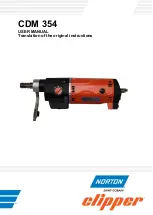
14 • ENGLISH
Setting the drilling depth (FIG. C)
f
Insert the depth stop (6) into the mounding hole
as shown.
f
Slacken the side handle (7) by turning the grip
counter clockwise.
f
Set the depth rod (6) to the desired position.
Note: The maximum drilling depth is equal to the distance
between the tip of the drill bit and the front end
of the depth rod.
f
Tighten the side handle by turning the grip clockwise.
Fitting a drill bit (FIG. D)
f
Open the chuck by turning the sleeve (5)
counter clockwise.
f
Insert the bit shaft (9) into the chuck.
f
Insert the chuck key (10) into each hole (8) in the side
of the chuck and turn clockwise until tight.
Removing and refitting the chuck (FIG. E)
f
Open the chuck as far as possible.
f
Remove the chuck retaining screw, located in the
chuck, by turning it clockwise using a screwdriver.
f
Tighten an Allen key. Remove the chuck by turning it
counter clockwise.
f
To refit the chuck, screw it onto the spindle and secure
it with the chuck retaining screw.
RESIDUAL RISKS
Additional residual risks may arise when using the tool
which may not be included in the enclosed safety warnings.
These risks can arise from misuse, prolonged use etc.
Even with the application of the relevant safety regulations
and the implementation of safety devices, certain residual
risks cannot be avoided. These include:
f
Injuries caused by touching any rotating/moving parts.
f
Injuries caused when changing any parts, blades
or accessories.
f
Injuries caused by prolonged use of a tool.
When using any tool for prolonged periods make sure
you take regular breaks.
f
Impairment of hearing.
f
Health hazards caused by breathing dust developed
when using your tool (example:- working with wood,
especially oak, beech and MDF).
USE
Warning! Let the tool work at its own pace. Do not overload.
Warning! Before drilling into walls, floors or ceilings,
check for the location of wiring and pipes.
Selecting the direction of rotation (FIG. F)
For drilling and for tightening screws, use forward
(clockwise) rotation. For loosening screws or removing a
jammed drill bit, use reverse (counter clockwise) rotation.
f
To select forward rotation, push the forward/reverse
slider
(3) to the centre position.
f
To select reverse rotation, push the forward/reverse
slider to the right.
Warning! Never change the direction of rotation while
the motor is running.
Selecting the drilling mode
f
For drilling in masonry, set the drilling mode selector
(4) to the position.
f
For drilling in other materials and for screwdriving, set
the drilling mode selector to the position.
Switching On and Off
f
To switch the tool on, press the variable speed switch
(1). The tool speed depends on how far you press
the switch. As a general rule, use low speeds for
large diameter drill bits and high speeds for smaller
diameter drill bits.
f
For continuous operation, press the lock-on button
(2) and release the variable speed switch. This option
is available only at full speed. This option does not
work in reverse rotation.
f
To switch the tool off, release the variable speed switch.
To switch the tool off when in continuous operation, press
the variable speed switch once more and release it.
MAINTENANCE
Your tool has been designed operate over a long period of
time with minimum of maintenance. Continuous satisfactory
operation depends proper tool care and regular cleaning.
Warning! Before performing any maintenance, switch
off and unplug the tool.
f
Regularly clean the ventilation slots in your tool using
a soft brush or dry cloth.
f
Regularly clean the motor housing using a damp cloth.
Do not use any abrasive or solvent-based cleaner.
Important! To assure product SAFETY and RELIABILITY,
repairs, maintenance and adjustment (other than those
listed in this manual) should be performed by authorized
service centers or other qualified service personnel,
always using identical replacement parts.
CLEANING
Warning! Blow dirt and dust out the main housing
with dry air as often as dirt is seen collecting in and
around the air vents. Wear approved eye protection and
approved dust mask when performing this procedure.
Содержание STDH6513
Страница 2: ...FIG A FIG B FIG D FIG E FIG C 4 3 1 2 6 6 7 5 5 9 8 10 7 7 ...
Страница 3: ...FIG F 3 ...


































